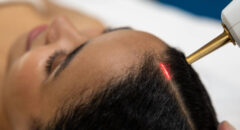Definition
Alopecia is a disease that can cause hair loss anywhere on the body. Many people with alopecia may develop unpredictable hair loss including a round or oval bald patch on their scalp and nail changes, but tend to remain in good health. Although alopecia can affect anyone, Black women are more prone to experience hair loss and often go undiagnosed. In fact, a condition called central centrifugal cicatricial alopecia (CCCA), a disorder in which inflammation and destruction of hair follicles causes scarring and permanent hair loss, is the leading cause of hair loss in Black women.
Black women are also more prone to traction alopecia, a type of hair loss that is caused by styles that pull the hair too tight.
Black women may also be affected by other hair disorders such as female pattern baldness.
A Black Women's Health Study at Boston University's Slone Epidemiology Center showed that of 5,594 women surveyed, 47.6 percent reported hair loss on the crown or top of the scalp.
Despite such a large number of Black women affected by alopecia, many don’t know that they should visit a dermatologist causing many to go undiagnosed. Of those surveyed, 81.4 percent indicated that they had never seen a physician about hair loss. Additionally, while 40.9 percent of respondents reported a level of hair loss consistent with CCCA, only 8.8 percent said a doctor had diagnosed them with this condition.
Causes
One major cause of hair loss in Black women is genetic predisposition. Another risk factor for hair loss is frequently engaging in damaging hairstyling practices like braiding, weaves and chemical relaxing.
Doctors are unsure why alopecia happens, but believe that genes may play an important role.
The following can increase your risk of developing alopecia:
- A family member who has it
- Asthma
- Down syndrome
- Pernicious anemia
- Seasonal allergies
- Thyroid disease
- Vitiligo
- Stress
- Medications
- Childbirth
- Physical trauma
- Restrictive dieting
- Life changes
- Hay fever
- Low iron
- Low vitamin D
- Unexplained weight changes
- High or low energy
- Menstruation changes
Symptoms
The most common symptoms of alopecia that you may notice are:
- Small bald patches on your scalp or other parts of your body
- Patches may get larger and grow together into a bald spot
- Hair grows back in one spot and falls out in another
- You lose a lot of hair over a short time
- More hair loss in cold weather
- Fingernails and toenails become red, brittle, and pitted
Treatments
Although alopecia can’t be cured, it can be treated and your hair can grow back. If you believe you are experiencing hair loss, you should visit a board-certified dermatologist, who has the expertise to diagnose and treat hair disorders. You can also manage and prevent your risk factors by avoiding tight hairstyles that put tension on the follicles, like braids and weaves, and limiting your use of chemical relaxers. If you must use these styles, you should do so in short periods of time.
The following are alopecia treatments you can try:
- Corticosteroids: These are anti-inflammatory drugs that are prescribed for autoimmune diseases. They can be given as an injection into the scalp or other areas. They can also be given as a pill or rubbed on the skin as an ointment, cream, or foam. The downside is that it may take a long time to work.
- Topical immunotherapy: This is used when there’s a lot of hair loss or if it happens more than once. Chemicals are applied to the scalp to produce an allergic reaction. If it works, this reaction is actually what makes the hair grow back. It also causes an itchy rash and usually has to be repeated several times to keep the new hair growth.
- Minoxidil (Rogaine): This treatment, which is put on the scalp, is already used for pattern baldness. It usually takes about 12 weeks before you see growth, and some users are disappointed in the results. Consult with your doctor about which types of alopecia are most likely to respond to minoxidil.
Medications that are sometimes used for other autoimmune disorders are also a treatment option for alopecia. These medicines have differing amounts of success in regrowing hair.









